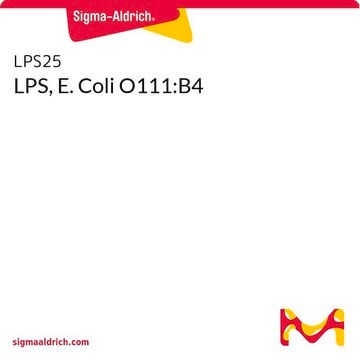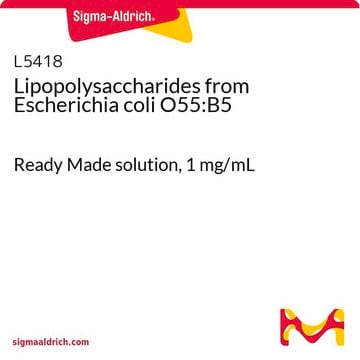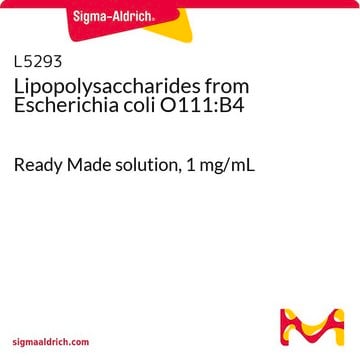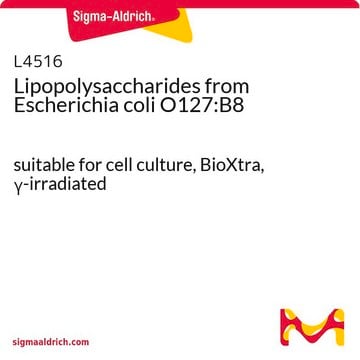If this product has an expiration or retest date, it will be shown on the Certificate of Analysis (COA, CofA). If there is no retest or expiration date listed on the product's COA, we do not have suitable stability data to determine a shelf life. For these products, the only date on the COA will be the release date; a retest, expiration, or use-by-date will not be displayed.
For all products, we recommend handling per defined conditions as printed in our product literature and website product descriptions. We recommend that products should be routinely inspected by customers to ensure they perform as expected.
For products without retest or expiration dates, our standard warranty of 1 year from the date of shipment is applicable.
For more information, please refer to the Product Dating Information document: https://www.sigmaaldrich.com/deepweb/assets/sigmaaldrich/marketing/global/documents/449/386/product-dating-information-mk.pdf
L2880
Lipopolysaccharides from Escherichia coli O55:B5
purified by phenol extraction
Synonym(s):
LPS
Select a Size
Select a Size
About This Item
Recommended Products
biological source
Escherichia coli (O55:B5)
Quality Level
form
lyophilized powder
purified by
phenol extraction
technique(s)
cell based assay: suitable
impurities
<3% Protein (Lowry)
color
off-white to tan
solubility
water: soluble
application(s)
cell analysis
clinical research
life science and biopharma
shipped in
ambient
storage temp.
2-8°C
Looking for similar products? Visit Product Comparison Guide
General description
Application
- to stimulate hepatocytes and non-parenchymal cells[4]
- to stimulate the spleen and study the expression of the Malitaf gene in the fish blunt snout bream[5]
- as part of the concanavalin A (ConA) and D-galactosamine/lipopolysaccharide (D-GalN/LPS) model of fulminant hepatitis to study the effect of the natural compound hesperetin[6]
- to check the cell viability of human chorionic villi-derived mesenchymal stem cells (hCMSCs) by methyl thiazolyl tetrazolium (MTT) assay[7]
- to induce oligodendrocyte toxicity to evaluate the neuroprotective effects of few compounds[8]
- to induce sarcopenia in rats to evaluate the antioxidant effects of curcumin-loaded hydrophobic surface-modified hydroxyapatite[9]
Biochem/physiol Actions
Other Notes
related product
signalword
Danger
hcodes
Hazard Classifications
Acute Tox. 2 Oral
Storage Class
6.1A - Combustible acute toxic Cat. 1 and 2 / very toxic hazardous materials
wgk_germany
WGK 3
flash_point_f
Not applicable
flash_point_c
Not applicable
ppe
Eyeshields, Gloves, type N95 (US)
Choose from one of the most recent versions:
Certificates of Analysis (COA)
Don't see the Right Version?
If you require a particular version, you can look up a specific certificate by the Lot or Batch number.
Already Own This Product?
Find documentation for the products that you have recently purchased in the Document Library.
Customers Also Viewed
Articles
Explore the structure, function, and diverse applications of Lipopolysaccharides. Discover their role in bacteria, serological specificity, and research potential.
-
How can I determine the shelf life / expiration / retest date of this product?
1 answer-
Helpful?
-
-
How is shipping temperature determined? And how is it related to the product storage temperature?
1 answer-
Products may be shipped at a different temperature than the recommended long-term storage temperature. If the product quality is sensitive to short-term exposure to conditions other than the recommended long-term storage, it will be shipped on wet or dry-ice. If the product quality is NOT affected by short-term exposure to conditions other than the recommended long-term storage, it will be shipped at ambient temperature. As shipping routes are configured for minimum transit times, shipping at ambient temperature helps control shipping costs for our customers. For more information, please refer to the Storage and Transport Conditions document: https://www.sigmaaldrich.com/deepweb/assets/sigmaaldrich/marketing/global/documents/316/622/storage-transport-conditions-mk.pdf
Helpful?
-
-
Hi, Can you provide the information regarding molecular weight of this LPS?
1 answer-
The molecular weight of this product has not been determined. In general, the molecular weight of native LPS may range from 1 – 4 million Daltons or higher. When treated with SDS and heat, the molecular weight of LPS may range from 50 to 100 kDa.
Helpful?
-
-
What is the number of acetyl groups attached to the lipid A moiety?
1 answer-
The acyl chain length and number of acyl groups may vary between bacterial species. Certain researchers claim there are 6 acyl groups for LPS from this strain of bacteria. Please refer to those peer reviewed papers below for more information.
Helpful?
-
-
Does the bacterial strain have specific information available, such as whether it originates from a private collection or if there is an associated ATCC number?
1 answer-
Unfortunately, the specific strains used to make L2880 are considered proprietary.
Helpful?
-
-
Can you provide information on the solubility and solution stability of this product?
1 answer-
LPS products in solution are expected to be stable in phosphate buffered saline at a concentration of 1 mg/mL when stored at 4 °C for at least one month. For long-term storage, it is recommended to use frozen aliquots. In order to prevent LPS binding to glass, it is advisable to store the solution in silanized containers. If glass containers are used, it is recommended to vortex the solutions for at least 30 minutes to dissolve any bound LPS.
Helpful?
-
-
hello, I was wondering what the best way to reconstitute this LPS is
1 answer-
LPS products can be reconstituted in phosphate buffered saline at 1 mg/mL.
Helpful?
-
-
Which LPS grade should be used to induce neurotoxicity in rats?
1 answer-
There is no Lipopolysaccharide product offered specifically for the induction of neurotoxicity in rats. Escherichia coli strain O55:B5 has been used to induce oligodendrocyte toxicity to evaluate the neuroprotective effects of certain compounds. In addition, Escherichia coli strain O111:B4 has been cited in the literature as suitable for LPS-induced neurotoxicity. For use with animal models, LPS purified by gel filtration is most commonly used to eliminate the risk of any residual solvents.
Please see the links below to review the E. coli strains O111:B4 and O55:B5 that have been purified by gel filtration:
Lipopolysaccharides – Glycobiology
https://www.sigmaaldrich.com/US/en/technical-documents/technical-article/research-and-disease-areas/cell-signaling/lipopolysaccharides
Lipopolysaccharides – selection table
https://www.sigmaaldrich.com/US/en/technical-documents/protocol/clinical-testing-and-diagnostics-manufacturing/bacteriology/lipopolysaccharidesHelpful?
-
Active Filters
Our team of scientists has experience in all areas of research including Life Science, Material Science, Chemical Synthesis, Chromatography, Analytical and many others.
Contact Technical Service




